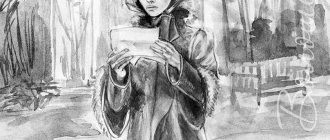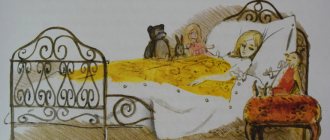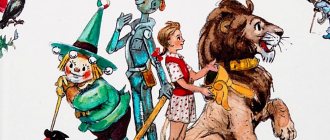- Summary
- Turgenev
- Forest and steppe
The story is included in the collection Notes of a Hunter
“Forest and Steppe” is a picture full of romance and beauty, written by the Russian classic Ivan Sergeevich Turgenev. He believes that hunters, among whom he counts himself, have the most keen eye for the charm of nature. They leave home early in the morning. They see the stars still glowing and melting in the sky, the pre-dawn wind blowing, the scarlet sun rising. The author shares his joy, how freely he can breathe and how wonderful this threshold of spring is.
In summer, nature has its own charm. Wet bushes, washed with dew, give their freshness to hunters and travelers before sunrise. And then the heat descends, and your path lies to the saving ravine, which is cool, a little damp and smells of hazel. Here you find a saving spring from which you take intoxicating sips.
Particularly sublime lines are dedicated by the Turgenevs to a sudden thunderstorm. Lightning on the horizon, a dark arm of a cloud, streams of water on the roof of the barn in which you are hiding. And then the delicious air, infused with the smells of porcini mushrooms, strawberries and flowers.
But then the fire of the setting sun flared in the sky, long gray shadows fled from the trees, the horizon turned blue, darkness was approaching. We must go home.
Every new sensation on the journey is the bright colors and subtle observations of the author. It seems that there is no action, but it’s as if you, too, have walked Turgenev’s road among the thick rye. And then he approached the quiet forest. This is already another autumn time. Hunting for hazel grouse. In the forest all around there is the aroma of withering, and it seems that the whole life one has lived suddenly passes before a person in a calm, even flow...
And here is an aspen grove on a frosty day. A golden birch tree among the snow is like a miracle. Snowdrifts and air that you can drink.
The author, with light strokes, paints impressions from different seasons: the dazzling sparkle of snowdrifts, warm spring earth, autumn fog, silence, joy of the soul. Turgenev brilliantly describes the light thawed patches, the sharpness of the air and the happiness that a person is able to understand beauty and enjoy it.
It’s as if no action takes place in the story “Forest and Steppe,” but you experience a surge of special emotions while reading the magnificent prose.
Turgenev. All works
- Andrey Kolosov
- Asya
- Asya by chapters
- Bezhin meadow
- Biryuk
- Brigadier
- Mayor
- On the road
- Spring waters
- Sparrow
- Hamlet of Shchigrovsky district
- Two landowners
- Two friends
- Noble Nest
- Diary of an Extra Man
- Smoke
- Ermolai and the miller's wife
- Living relics
- Breakfast with the leader
- Notes of a Hunter
- The story of Lieutenant Ergunov
- Kasyan with a beautiful sword
- Clara Milic
- The end of Tchertopkhanov
- Office
- Lebedyan
- Forest and steppe
- Lgov
- Raspberry water
- A month in the village
- My neighbor Radilov
- Mu Mu
- The day before
- Freeloader
- Beggar
- New
- Odnodvorets Ovsyannikov
- Fathers and Sons
- Singers
- First love
- First love by chapters
- Song of Triumphant Love
- Pyotr Petrovich Karataev
- Trip to Polesie
- Provincial
- Punin and Baburin
- Father Alexey's story
- Rudin
- Date
- Death
- Dog
- Dream
- King Lear of the Steppes
- Strange story
- Knocking!
- Tatyana Borisovna and her nephew
- Three meetings
- District doctor
- Faust
- Bachelor
- Khor and Kalinich
- Watch
- Tchertophanov and Nedopyuskin
Summary of the story “Forest and Steppe” by I. S. Turgenev
Turgenev wrote the story “Forest and Steppe” in 1849 and is a chapter from the series “Notes of a Hunter.” Of course, Turgenev always pays a lot of attention to the beautiful Russian nature, but here there are no heroes at all. Is it a hunter with his senses of nature? Beautiful pictures of all seasons, all states of nature are shown. In these sketches, either a white bird flies up in a white forest, or a summer dawn... and everything is amazing.
On our website you can read a summary of “ Forest and Steppe” to prepare for a literature lesson:
Hunting with a gun and a dog is wonderful in itself, but even if you are not a hunter, but just love nature, you cannot help but envy our brother. What a pleasure it is to leave home before dawn in the spring! The stars are blinking in the dark gray sky, the damp breeze is coming in a light wave, and the vague whisper of the night is heard.
But the edge of the sky turns red, birds wake up, the air brightens. Now golden stripes stretch across the sky, the pre-dawn wind blows - and the crimson sun quietly rises. The weather will be nice. How freely the chest breathes, how a person, captured by the breath of spring, grows stronger!
And who, besides the hunter, has experienced how pleasant it is to wander through the bushes on a summer July morning? You part the bush, wet with dew, and the warm smell of the night washes over you. It’s still fresh, but you can already feel the heat coming. The sun is getting higher. It's already getting hot.
Through dense hazel bushes you descend into a ravine, where a spring lurks just under the cliff. You get drunk and remain in the shadows, breathing in the odorous dampness. Suddenly the wind blows. The sun is still shining all around, but lightning is already flickering faintly on the horizon. The cloud covers the arch with a dark sleeve, and you hide in the hay barn. How fresh the air is after a thunderstorm, how it smells like mushrooms and strawberries!
But then the dawn engulfed half the sky in fire, and the sun was setting. Along with the dew, a scarlet shine falls onto the clearings; long shadows run from the trees and bushes. The sun has set, the sky is turning blue, the air is filled with darkness. Time to go home.
Otherwise you’ll start a racing droshky and go into the forest to hunt hazel grouse. It's fun to make your way along the narrow path between two walls of tall rye. The forest greets you with shadow and silence. You drive further and further along the green path. The forest is dying, all around is drowsy and quiet. And how beautiful this forest is in late autumn, when the autumn scent is permeated in the soft air. All life unfolds before a person like a scroll, and nothing interferes with him - there is no sun, no wind, no noise.
And on an autumn, clear, frosty morning, when the sun no longer warms, the small aspen grove is all sparkling, and the birch tree is all golden, like a fairy-tale tree. Foggy summer days are also good, when the surroundings are incredibly quiet.
And on a winter day, walk through the snowdrifts, breathe in the frosty sharp air and squint at the dazzling sparkle of the soft snow. And the first days of spring, when everything around is glittering and melting, through the heavy steam of melted snow there is already the smell of warmed earth and larks are singing in the thawed patches.
However, it's time to end. In spring it is easy to part ways, in spring even the happy are drawn into the distance...
Conclusion:
The author presents pictures of nature, and it is felt that he did not invent, for example, the crimson stripes of dawn or the fabulous birch tree - golden from the winter sun. No, he saw it all himself, felt it and managed to convey it to his readers. The author created a “three-dimensional” picture: colors, smells, sensations... The forest and the steppe are compared, without contrast. Everything is expressed in precise words.
You can use the “Forest and Steppe” summary for a reader’s diary, highlighting a few main sentences.
Autumn and winter
You can go into the forest to hunt hazel grouse. This is a great opportunity to take in the surrounding beauty and shadows. Now the birds are chirping, and there you can see an oak tree among the linden trees. There are gnats and flies all around, and the incomparable scents of lilies of the valley can be heard.
In the canopy the forest delights with new colors and smells . Foggy days are especially beautiful, often occurring in the summer. Such a time is not welcomed by hunters, but you can still admire the mesmerizing beauty around. If you go to the steppe through the fields, magpies will fly by.
You can hunt hares and breathe in the fragrant air on a winter day. The snowball blinds your eyes with its sparkling, you want to admire the vaults of heaven endlessly.
And how beautiful the forest is in early spring, when the snowdrifts have not yet melted, but in some places thawed patches are already visible. This is the time when you can hear the first songs of the larks.
In his work, the author describes steppes, fields and forests. He talks about the beautiful landscapes that attract him.
The writer wants to show the surrounding nature . He strives to teach the reader to notice its beauty in different seasons.
Analysis of the story “Forest and Steppe”
In the mid-19th century, Ivan Turgenev published a number of stories in the domestic magazine Sovremennik, which were later included in the series Notes of a Hunter and published as a separate book. Most stories have a certain plot in which characters participate. Nature often complements interesting character dialogue. The exception is the story “Forest and Steppe,” the literary form of which has not yet been determined. Some critics are sure that the story is an essay, while others are sure that it is a short story.
The story “Forest and Steppe” does not have direct speech. The narrative is based on a monologue by an experienced hunter, whose name nevertheless turns out to be known to readers. The hunter's name is Petr Petrovich Karataev. He has the ability to observe life and nature, progressive views. Petr Karataev loves his native nature very much, in which he is able to find numerous notes of beauty.
“Forest and Steppe” can be considered an unusual epilogue to the collection “Notes of a Hunter” and an amazing hymn and even an ode to Russian nature, because the story personifies the beauty of the landscape. The main text is revealed after the introduction of the epigraph, which turns out to be the “highlight” of the work. Turgenev practically did not use epigraphs for his stories.
"Forest and Steppe" is a work that emphasizes the valuable fact that Turgenev is a master of landscape. Each description of nature presented in a story or essay turns out to be perfect, because the words are amazingly chosen to each other.
Ivan Turgenev in a short passage can convey numerous nuances of the perception of nature:
•
color;
•
light;
•
smell;
•
sound;
•
movement;
•
tactile sensations.
All this helps ensure that every reader is able to imagine a certain picture of nature, understanding its amazing beauty.
The beauty of the landscapes of central Russia involves the use of numerous literary devices and associations: •
literary techniques that reveal Turgenev’s talent as a writer;
•
a rich palette of colors and their shades, conveyed in verbal form;
•
richness and variety of linguistic means: adverbs, verbs, adjectives.
For example, Turgenev selected three definitions for the sky at once:
•
pale blue;
•
vaguely clear;
•
turns pale.
Such definitions make it possible to imagine how everything changes and how nature reveals its various facets...
Ivan Turgenev shows mastery in a refined use of words, so he reflects the description of nature with particular emotionality and understanding of the Russian world. The elements of nature illuminate the inner world of an ordinary person and determine his emotional state.
It is important to note that Ivan Turgenev’s autumn landscape does not cause even a drop of sadness:
•
the river waters rush joyfully and swiftly;
•
The grove is easy to stand naked as it captures notes of fun.
Turgenev tries to personify nature:
•
aspen trees can babble;
•
oak resembles a mighty fighter;
•
linden surprises with its beauty.
Moreover, Ivan Turgenev successfully uses scents, with the help of which almost every reader is even more immersed in emotional stories:
•
spring has fresh breath;
•
summer fills the air with buckwheat honey and the bitterness of wormwood;
•
In winter you can feel the sharp frosty air.
Even sounds find a place in a literary work:
•
the faint sound of trees in the dead of night;
•
scythe clanging;
•
the creaking of a passing cart;
•
the golden voice of a robin bird;
•
the silence of the morning forest.
Numerous descriptions and correctly chosen words contribute to the creation of a deep work “Forest and Steppe”, a bright and holistic composition.
Spring and summer
At the very beginning, the author says that he is happy to be a hunter, because it gives him the opportunity to admire the beautiful nature from a variety of angles. If you have time to leave before dawn in the spring, you can see the stars twinkling in the sky, feel the wind, and hear the night whisper. How nice it is to walk along the river and watch how the sky brightens and how everything around wakes up. There is a beautiful view from the mountain.
In summer, going hunting is no less fun. The author says that he likes to wander around the bushes at dawn in July. There are such indescribable aromas around, everything smells fragrant and blooms! Smells:
- porridge;
- buckwheat;
- wormwood.
In the distance you can see a forest, there is no end to the bushes. It’s still very early, but you can already feel the heat slowly creeping up. Here comes a cart with a man who is going to mow the grass. The sun rises higher and higher. Due to the rising temperature, you begin to feel thirsty and want cool water. Fortunately, there is a ravine nearby, at the bottom of which there is a spring. After quenching your thirst, you have no desire to go anywhere. I want to stay in the shade and just inhale the smell of dampness. But suddenly the wind suddenly rises and thunderclaps are heard .
There is still an opportunity to hunt, but the cloud grows and it starts to rain. You can hide in the barn and just admire the lightning. The rain ends quickly, and nature becomes even more beautiful after the rain. In the sun everything glitters and sparkles, the air is somehow special.
Evening comes, and it is also beautiful. It's interesting to watch the shadows fall.
After sunset, the stars appear, the air is filled with darkness, and not a trace remains of the shadows. It's time to return home, where a delicious dinner and a warm bed await you.
The role of nature in Turgenev’s work
Ivan Turgenev is, first of all, a landscape writer.
In almost every work, nature plays a large role. The series “Notes of a Hunter” reveals amazing facets of the landscape, each of which contributes to the creation of a detailed and faithful composition. Ivan Turgenev expresses his opinion, expresses the feelings of a knowledgeable and understanding person. The story “Forest and Steppe” proves that Turgenev has a deep and sincere contact with the nature of his native land. Each work of Ivan Turgenev turns out to be psychological, deep, true, and close to every person. But the story “Forest and Steppe” is a special masterpiece, where the writer actually declared his love for his native land, his native land. This is a real hymn to Russian nature.






